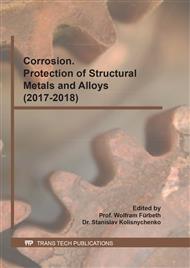[1]
A. Ulman, Formation and Structure of Self-Assembled Monolayers. Chem. Rev. 96 (1996) 1533-1554.
DOI: 10.1021/cr9502357
Google Scholar
[2]
M. Maciej, P. Krysin´ski, Covalently Immobilized 1, 4-Phenylenediamine on 11-Mercaptoundecanoic Acid-Coated Gold: Effect of Surface-Confined Monomers on the Chemical in Situ Deposition of Polyaniline and Its Derivatives. Langmuir. 17 (2001).
DOI: 10.1021/la001661c
Google Scholar
[3]
W. Hua, C. Shengfu, L. Linyan, J. Shaoyi, Improved Method for the Preparation of Carboxylic Acid and Amine Terminated Self-Assembled Monolayers of Alkanethiolates, Langmuir. 21 (2005) 2633-2636.
DOI: 10.1021/la046810w
Google Scholar
[4]
T. Ignat, M. Miu, I. Kleps, A. Bragaru, M. Simion, M. Danila, Electrochemical characterization of BSA/11-mercaptoundecanoic acid on Au electrode Mater. Sci. Eng., B. (2009).
DOI: 10.1016/j.mseb.2009.11.021
Google Scholar
[5]
Y. Song, Z. Li, Z. Liu, G. Wei, L. Wang, L. Sun, Immobilization of DNA on 11-mercaptoundecanoic acid-modified gold (111) surface for atomic force microscopy imaging. Microsc. Res. Tech, 68 (2005) 59-64.
DOI: 10.1002/jemt.20235
Google Scholar
[6]
G. Robert, E. O. Chapman, S. Takayama, R. E. Holmlin, Y. Lin, M. G. Whitesides, Surveying for Surface that Resist the Adsorption of Proteins. J Am. Chem. Soc, 122 (2000) 8303-8304.
DOI: 10.1021/ja000774f
Google Scholar
[7]
C.L. Huang, C. W. Chang, J. D. Liao, Y. T. Wu, C. C. Lin. M.S. Ju, Cells anchored upon a thin organic film with different nano-mechanical properties Appl. Surf. Sci, 255 (2008) 301-303.
DOI: 10.1016/j.apsusc.2008.06.104
Google Scholar
[8]
Y. Arima, H. Wata, Effects of surface functional groups on protein adsorption and subsequent cell adhesion using self-assembled monolayers. J. Mater. Chem, 17 (2007) 4079 - 4087.
DOI: 10.1039/b708099a
Google Scholar
[9]
H. Wang, D. Castner, B. Ratner, S. Jiang, Probing the Orientation of Surface-Immobilized Immunoglobulin G by Time-of-Flight Secondary Ion Mass Spectrometry. Langmuir, 20 (2004) 1877-1887.
DOI: 10.1021/la035376f
Google Scholar
[10]
M. Maciej, P. Krysin´ski, Covalently Immobilized 1, 4-Phenylenediamine on 11-Mercaptoundecanoic Acid-Coated Gold: Effect of Surface-Confined Monomers on the Chemical in Situ Deposition of Polyaniline and Its Derivatives. Langmuir, 26 (2006).
DOI: 10.1021/la001661c
Google Scholar
[11]
N. Sakuragi, S. Yamamoto, Y. Koide. A Self-Assembled Monolayers Assisted Solid-State Conversion of Boehmite Particles to Aluminum Oxide Film. J. Am. Chem. Soc. 129 (2007) 10048-10049.
DOI: 10.1021/ja068981o
Google Scholar
[12]
Y. J. Wang, P. Pratixa, K. L. Hobbs, M.B. Johnson, W. David, Nanostructured Biosensors Built by Layer-by-Layer Electrostatic Assembly of Enzyme-Coated Single-Walled Carbon Nanotubes and Redox Polymers. Langmuir, 22 (2006) 9776-9783.
DOI: 10.1021/la060857v
Google Scholar
[13]
S.B. Wang, C. Li, F.E. Chen, G.Q. Shi, Nanotechnology, 18 (2007) 1-6.
Google Scholar
[14]
X.W. Fan, L.J. Lin, L.D. Jeffrey, B. Phillip, Biomimetic Anchor for Surface-Initiated Polymerization from Metal Substrates. J. Am. Chem. Soc, 127 (2005) 15843-15847.
DOI: 10.1021/ja0532638
Google Scholar
[15]
L. D. Jeffrey, B. H. Hu, B. P. Lee, P. B. Messersmith, Mussel Adhesive Protein Mimetic Polymers for the Preparation of Nonfouling Surfaces. J. Am. Chem. Soc. 125 (2003) 4253-4258.
DOI: 10.1021/ja0284963
Google Scholar
[16]
L.D. Jeffrey, L.J. Lin, S. Tosatti, J. Voros, M. Textor, P.B. Messersmith, Protein Resistance of Titanium Oxide Surfaces Modified by Biologically Inspired mPEG-DOPA, Langmuir, 21 (2005) 640-646.
DOI: 10.1021/la048626g
Google Scholar
[17]
S. G. Chen, Y. Chen, Y. H. Lei, Y. S. Yin, Novel strategy in enhancing stability and corrosion resistance for hydrophobic functional films on copper surfaces. Electrochem. Commun, 11 (2009) 1675-1679.
DOI: 10.1016/j.elecom.2009.06.021
Google Scholar
[18]
C.D. Wagner, J. F. Moulder, J. E. Davis, W. M. Riggs, Handbook of X-ray photoelectron spectroscopy. (1992).
Google Scholar
[19]
C. B. Gorman, Y. F. He, R. L. Carroll, The Influence of Headgroup on the Structure of Self-Assembled Monolayers as Viewed by Scanning Tunneling Microscopy. Langmuir, 17 (2001) 5324-5328.
DOI: 10.1021/la0013998
Google Scholar
[20]
F. Bernsmann, A. P., C. Ringwald, J. Hemmerle, J. Raya, B. Bechinger, Characterization of Dopamine−Melanin Growth on Silicon Oxide, J. Phys. Chem. C., 2009, 113, 8234-8242.
DOI: 10.1021/jp901188h
Google Scholar
[21]
C. B. Gorman, Y. F. He, R. L. Carroll, The Influence of Headgroup on the Structure of Self-Assembled Monolayers As Viewed by Scanning Tunneling Microscopy, Langmuir, 2001, 17, 5324-5328.
DOI: 10.1021/la0013998
Google Scholar
[22]
S.M. Mendoza, I. Arfaoui, S. Zanarini, F. Paolucci, P. Rudolf, Langmuir., 2007 (23) 582-588.
Google Scholar
[23]
H. Lee, S.M. Dellatore, E. M. Miller, P. B. Messersmith, Mussel-inspired surface chemistry for multifunctional coating, Science., 2007, 318, 426-430.
DOI: 10.1126/science.1147241
Google Scholar
[24]
S. Gidanian, P. J. Farmer, Redox behavior of melanins: direct electrochemistry of dihydroxyindole-melanin and its Cu and Zn adducts. J. Inorg. Biochem, 89 (2002) 54-60.
DOI: 10.1016/s0162-0134(01)00405-6
Google Scholar
[25]
M. Behpour, S. M. Ghoreishia, M. Salavati-Niasaria, B. Ebrahimia, Mater. Chem. Phys, 107 (2008) 153-157.
Google Scholar
[26]
K.F. Khaled, Guanidine derivative as a new corrosion inhibitor for copper in 3% NaCl solution. Mater. Chem. Phys, 112 (2008) 104-111.
DOI: 10.1016/j.matchemphys.2008.05.052
Google Scholar
[27]
M. Qian, A. M. Soutar, X. H. Tan, X. T. Zeng, S.L. Wijesinghe, Two-part epoxy-siloxane hybrid corrosion protection coatings for carbon steel, Thin Solid Films, 517 (2009) 5237-5242.
DOI: 10.1016/j.tsf.2009.03.114
Google Scholar
[28]
T. Liu, S. G. Chen, S. Cheng, J. T. Tian, X. T, Chang, Y. S. Yin, Corrosion behavior of super-hydrophobic surface on copper in seawater, Electrochemical Acta, 52 (2007) 8003-8007.
DOI: 10.1016/j.electacta.2007.06.072
Google Scholar



